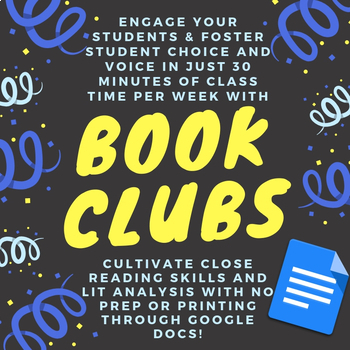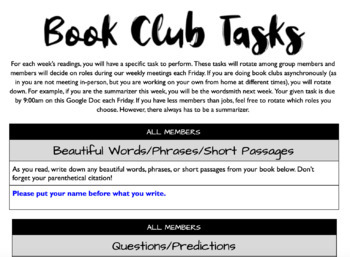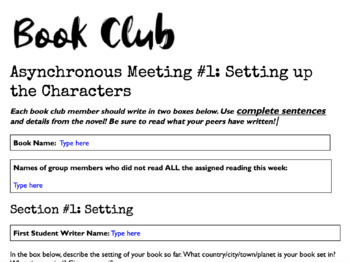Book Clubs & Lit Circles Made Easy with Google Docs! Updated for Online Learning
- Google Docs™

What educators are saying
Description
Now updated to include a remote, asynchronous online book club option due to COVID-19! Note: If you are moving to all-online learning due to the pandemic, I would suggest students choose public domain books that can be found for free online. Here is a great site to visit for public domain books!
Want to infuse more student choice in your classroom? Need to facilitate deep literary analysis? Desperately need a better way to hit and assess those speaking and listening standards? Class book clubs (literature circles) to the rescue! With just 30 minutes each Friday (or whatever day you choose) for 6 weeks (or more!) you can foster better readers, speakers, listeners, and analyzers!
Best of all? There is no need to print a thing! Simply copy and paste each meeting into a Google Doc and post it to Google Classroom!
How do I facilitate book clubs in my 9th grade classroom?
First, I have students get into groups of 3-5 (you can choose to group students yourself, but I've found that students are much more apt to participate in weekly discussion - and get more in-depth! - when they choose the groups themselves). I have a list of recommended books for students to tackle (and I encourage each group to pick a challenging book), but ultimately it is up to the students to pick a book that the group will read. I do ask that students choose a book that no one in the group has read before. Next, I allow my students to research book reviews to ensure they are informed about the book they are choosing. Students are then given a week and a half to get the book (in my class I allow physical books and ebooks). During our first Friday meeting, students bring their books to class and divide the chapters into six weeks of reading. I allow them to divide the chapters themselves, but each member needs to be in agreement of which chapters will be due each week to best facilitate the book club meetings each Friday. I have included a book club group planning section to help students monitor their reading habits and divide up the reading! Each week, students rotate literature circle roles (the summarizer, the word smith, the connector, the discussion director, and the character tracker) and complete their given tasks in preparation for Friday's meeting. Students share a Google Doc (included in this resource!) that contains guiding questions for each role and a place to type their thinking/answers. Finally, each Friday book clubs sit together and spend 30 minutes of the beginning of the class period discussing different aspects of the book. Each group shares a Google Doc containing that week's guiding questions and students rotate typing the group's answers (note: I have a class set of Chromebooks in my classroom, but this could absolutely work with only one device per group! No tech? No problem! Just tweak the Google Doc and print one copy per group!). During each meeting, I float around the room and note students who are not participating, ask follow-up questions, and answer clarifying questions about the week's meeting topic. At the end of the six weeks of reading, students write a critical book review! So many reading, writing, speaking, and listening standards hit in just 30 minutes of class time per week!
This resource contains:
- Book Club Planning Sheet
- Literature Circle Jobs: Simply copy and paste this section into a Google Doc, post on Google Classroom, and ask students to make a copy to share with their group. Repeat each week.
- All Weekly meetings have an in-person and asynchronous online option!
- Week 1 Meeting Focus: Setting & Characterization - Students will discuss how the author of their novel uses exposition to introduce the characters in the story.
- Week 2 Meeting: Plot Elements - Students explore the central conflict and rising action, making predictions based on the point of view and text structure.
- Week 3 Meeting: Author's Style and Tone - Students delve deeply into the author's diction, syntax, tone, and use of literary devices/elements.
- Week 4 Meeting: Theme - Students analyze how the author's use of literary devices, characterization, plot, etc. establish the theme.
- Weeks 5 & 6 Meetings: Critical Book Review - As students finish their novels, they will write a book review in which they will not only give a star rating, but analyze the author's overall effectiveness.
Need to stretch these activities or shorten the number of weeks? Simply tweak the Google Doc sections to meet your needs!
Don't have the tech available to facilitate these activities via Google Docs? No problem! Simply tweak this resource by manipulating the space in each box (enough for students to hand write the information) and print! Easy peasy!
This product also aligns with Oklahoma ELA Academic Standards!
6th Grade: 6.3.R.2, 6.3.R.3, 6.3.R.4, 6.3.R.6, 6.3.R.7, 6.1.R.1, 6.1.R.2, 6.1.R.3, 6.1.W.1, 6.1.W.2, 6.4.R.1, 6.4.R.3, 6.4.W.1, 6.5.W.1, 6.6.W.4
7th Grade: 7.3.R.2, 7.3.R.3, 7.3.R.4, 7.3.R.6, 7.3.R.7, 7.1.R.1, 7.1.R.2, 7.1.R.3, 7.1.W.1, 7.1.W.2, 7.4.R.1, 7.4.R.3, 7.4.W.1, 7.5.W.1, 7.6.W.4
8th Grade: 8.3.R.2, 8.3.R.3, 8.3.R.4, 8.3.R.6, 8.3.R.7, 8.1.R.1, 8.1.R.2, 8.1.R.3, 8.1.W.1, 8.1.W.2, 8.4.R.1, 8.4.R.3, 8.4.W.1, 8.5.W.1, 8.6.W.4
9th Grade: 9.3.R.2, 9.3.R.3, 9.3.R.4, 9.3.R.6, 9.3.R.7, 9.1.R.1, 9.1.R.2, 9.1.R.3, 9.1.W.1, 9.1.W.2, 9.4.R.1, 9.4.R.3, 9.4.W.1, 9.5.W.1, 9.6.W.4
10th Grade: 10.3.R.2, 10.3.R.3, 10.3.R.4, 10.3.R.6, 10.3.R.7, 10.1.R.1, 10.1.R.2, 10.1.R.3, 10.1.W.1, 10.1.W.2, 10.4.R.1, 10.4.R.3, 10.4.W.1, 10.5.W.1, 10.6.W.4
11th Grade: 11.3.R.2, 11.3.R.3, 11.3.R.4, 11.3.R.6, 11.3.R.7, 11.1.R.1, 11.1.R.2, 11.1.R.3, 11.1.W.1, 11.1.W.2, 11.4.R.1, 11.4.R.3, 11.4.W.1, 11.5.W.1, 11.6.W.4
12th Grade: 12.3.R.2, 12.3.R.3, 12.3.R.4, 12.3.R.6, 12.3.R.7, 8.1.R.1, 12.1.R.2, 12.1.R.3, 12.1.W.1, 12.1.W.2, 12.4.R.1, 12.4.R.3, 12.4.W.1, 12.5.W.1, 12.6.W.4
Before Purchasing:
- Licensing - Please remember this is a single use license. If you plan to share with a grade level, please purchase the multiple use license at check out. This is a small add-on that allows me to continue making great resources. If you are an administrator purchasing this product for school use, please purchase the school license. This product may not be shared via email, shared drive, hard copy, or school website.
Thank you for supporting this Oklahoma teacher mom! All proceeds from my Teachers Pay Teachers profits go to paying for my four-year-old son's martial arts lessons, my soon-to-be baby girl's birth medical expenses, and paying down debt from years of buying my own school/classroom supplies. Please continue supporting my work by following me on TpT and Facebook (Page Name: Adventures with Mrs. Anderson: Oklahoma Curriculum Designer)! Don't hesitate to email AdventureswithMrsAnderson@gmail.com if you have any questions!





